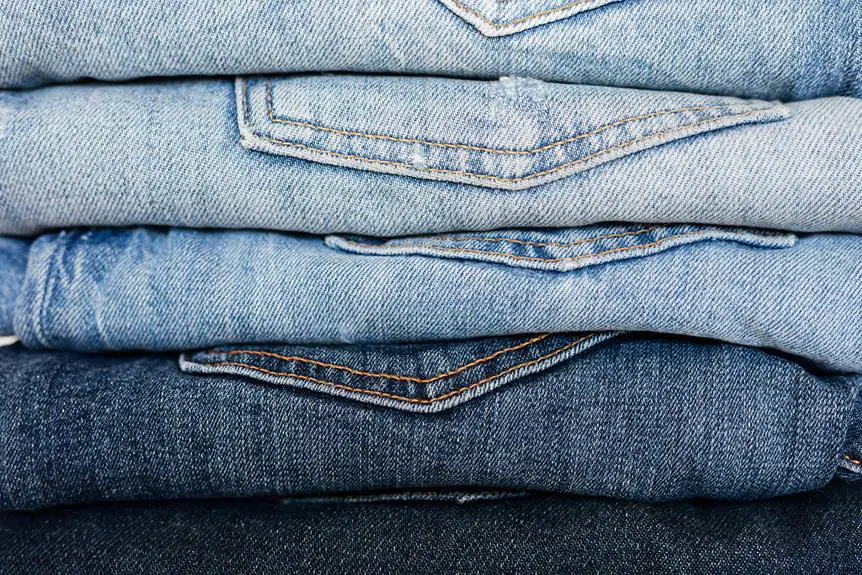When it comes to storing your fabric off-season, it's essential to approach the task methodically to ensure your collection remains in top condition. Start by assessing what you have and eliminating any unusable pieces; you wouldn't want to waste space. Next, consider the containers you choose and the conditions in which you'll store them. But before diving into all the specifics, let's explore the critical steps that can make a significant difference in preserving your fabrics' quality for future projects.
Table of Contents
Key Takeaways
- Assess and organize your fabric collection by type and color, discarding unusable pieces and creating a plan for disposal of unwanted fabrics.
- Clean fabrics thoroughly by removing stains and washing according to care labels, ensuring they are dry and wrinkle-free before storage.
- Choose breathable, acid-free storage containers to protect fabrics, avoiding plastic unless specifically designed for fabric.
- Store fabrics in a climate-controlled environment, maintaining a temperature of 60-70°F and humidity levels between 30-50% to prevent damage.
Assessing Your Fabric Collection
Before you dive into storing your fabric, take a moment to assess your collection and determine what you'll keep, donate, or discard. Start by gathering all your fabric in one spot, making it easier to evaluate each piece. As you sift through your collection, consider the fabric's condition, weight, and usability. Are there any remnants that you can't envision using again? If so, set those aside for donation or recycling.
Next, think about the projects you've been planning. Do you have fabrics that no longer inspire you or don't fit your style? Letting go of these pieces can free up space for new materials that excite you. Remember, it's okay to part with fabric that no longer serves a purpose in your creative journey.
Once you've made your decisions, organize the fabrics you're keeping by type, color, or project. This won't only simplify the storing process but also make it easier to locate what you need when inspiration strikes. By taking the time to assess your collection thoughtfully, you'll create a more manageable and inspiring workspace for your future projects.
Choosing the Right Containers
When it comes to storing your fabric, the right containers can make all the difference.
You'll want to consider the material, size, and shape of the containers to ensure your fabric stays protected and organized.
Let's explore how these factors can help you maintain the quality of your collection.
Material Selection for Containers
Choosing the right materials for your storage containers can significantly impact the longevity and condition of your fabric. When selecting containers, prioritize breathable materials like cotton or linen for natural fibers. These fabrics allow air circulation, preventing moisture buildup and mildew.
Avoid plastic containers that can trap humidity unless they're specifically designed for fabric storage, as they can lead to mold growth. If you prefer plastic, opt for acid-free options that won't damage your fabric over time. Look for containers with a secure lid to protect against dust and pests, but ensure they've some ventilation.
Cardboard is another option, especially if it's acid-free and sturdy, but keep in mind that it may not provide the best protection against moisture. For delicate fabrics, consider using padded storage bags made from breathable materials. They can offer extra protection while still allowing air circulation.
Always steer clear of containers that have been treated with chemicals, as these can transfer harmful substances to your fabric. Finally, think about how you'll label your containers, as easy identification will save you time when it's time to retrieve your stored items.
Size and Shape Considerations
Selecting the right size and shape of storage containers is crucial for maximizing space and ensuring your fabric remains in good condition. When you choose containers, consider how much fabric you need to store and what types of fabric you have.
Here are some key points to keep in mind:
- Size: Use containers that are large enough to hold your fabric without cramming it in. This prevents creases and damage.
- Shape: Opt for rectangular or square containers for efficient stacking. These shapes fit better in closets or under beds compared to round ones.
- Material: Choose sturdy containers that won't warp or break easily. Plastic bins with lids are great for durability and protection from dust.
- Accessibility: Ensure your containers are easy to open and close. If you'll be accessing your fabric frequently, consider clear containers for quick visibility.
Cleaning Fabrics Before Storage
Before you store your fabrics, it's essential to clean them properly to prevent any damage.
Start by removing stains promptly, then use the right washing techniques to keep your fabrics in top condition.
Don't forget about drying and ironing tips to ensure everything looks great when you take it out of storage.
Remove Stains Promptly
To keep your fabrics in top condition, always remove stains promptly before storing them away for the season. Ignoring stains can lead to permanent damage, making it essential to act fast.
Here's a straightforward approach to tackle stains effectively:
- Identify the Stain: Determine what caused the stain to choose the right cleaning method. Different stains require different treatment.
- Blot, Don't Rub: Use a clean cloth to gently blot the stain. Rubbing can spread the stain and damage the fabric fibers.
- Use Cold Water: Rinse the stained area with cold water. Hot water can set some stains, making them harder to remove.
- Apply a Stain Remover: Use a suitable stain remover for the fabric type. Test it on a small, inconspicuous area first to ensure it won't cause discoloration.
Proper Washing Techniques
Cleaning your fabrics properly before storing them ensures they stay fresh and in great condition for the next season. Start by checking the care labels on your fabrics, as they provide essential washing instructions. Use a gentle detergent to avoid damaging delicate fibers.
Here's a simple guide to help you with the washing process:
| Fabric Type | Recommended Wash Cycle | Water Temperature |
|---|---|---|
| Cotton | Normal | Warm |
| Polyester | Permanent Press | Cold |
| Wool | Gentle | Cold |
| Silk | Delicate | Cold |
Make sure to wash similar fabrics together to prevent any potential damage. If a fabric is particularly soiled, consider pre-treating those areas before washing. Avoid overloading your washer, as this can prevent thorough cleaning. After washing, always inspect your fabrics for any remaining stains or odors. Once you're satisfied, you're ready to move on to drying and ironing, ensuring your fabrics are perfectly prepared for storage.
Drying and Ironing Tips
Drying and ironing your fabrics properly is essential for maintaining their quality and ensuring they're ready for storage. After washing, it's crucial to handle your fabrics with care to prevent damage. Here are some tips to follow:
- Air Dry: Whenever possible, hang your fabrics to air dry. This method is gentle and helps preserve their texture and color.
- Avoid Direct Sunlight: Keep your fabrics out of direct sunlight while drying to prevent fading and degradation of fibers.
- Use a Low Heat Setting: If you must use a dryer, opt for a low heat setting to avoid shrinking or damaging delicate fabrics.
- Iron While Damp: For the best results, iron your fabrics while they're still slightly damp. This makes it easier to remove wrinkles and achieve a crisp finish.
Optimal Storage Conditions
Maintaining the right temperature and humidity levels is crucial for preserving your fabric's quality during off-season storage. Aim for a cool, dry environment, ideally between 60-70°F with humidity levels around 30-50%. This range helps prevent mold growth and fabric degradation.
To achieve these conditions, consider using a climate-controlled space or a dedicated storage area in your home. Avoid placing your fabric in damp basements or hot attics, as these extremes can cause irreversible damage. If you can't control the environment, invest in dehumidifiers or air conditioners to maintain optimal conditions.
It's also smart to store your fabric in breathable containers, like cotton bags or acid-free boxes, which allow air circulation while protecting against dust. Avoid plastic bags, as they can trap moisture and lead to mildew.
Make sure to keep the storage area clean and free from clutter to minimize the risk of accidents. Regularly check on your stored fabric, ensuring the temperature and humidity remain stable. By creating and maintaining these optimal storage conditions, you'll keep your fabric in excellent shape, ready for your next project when the season returns.
Preventing Pests and Damage
Even in ideal storage conditions, it's important to take steps to prevent pests and damage that can compromise your fabric's integrity. You might think your fabric is safe, but pests like moths, silverfish, and even rodents can find their way into your storage area.
Here are some effective strategies to keep your fabric protected:
- Use airtight containers: Store your fabric in sealed plastic bins or vacuum bags. This limits airflow and deters pests from entering.
- Include natural repellents: Consider adding lavender sachets or cedar blocks to your storage. These natural repellents help keep bugs at bay without harmful chemicals.
- Regularly inspect your storage area: Check for any signs of pests or moisture. If you notice anything suspicious, act quickly to prevent further damage.
- Avoid stacking heavy items on top: This can cause creases or damage to your fabric. Instead, store fabric neatly and allow for adequate space around each piece.
Labeling and Organizing
Organizing and labeling your fabric collection not only saves time when you need it but also ensures you can quickly find exactly what you're looking for. Start by sorting your fabrics by type, color, or project. This way, you'll know where everything is at a glance.
Once sorted, use clear, durable labels for each bin or shelf. Consider including details like fabric type, color, and yardage. You can use a label maker, write directly on masking tape, or even use colorful sticky notes for a creative touch.
If you have multiple pieces of the same fabric, stack them neatly and label them with their respective sizes. For smaller scraps, consider using clear bags with labels to keep them organized and visible.
Don't forget to keep an inventory list handy. This will help you track what you have and avoid duplicate purchases.
As you label and organize, you'll find that working on projects becomes more enjoyable and efficient. So, take the time to set up a system that works for you, and you'll reap the benefits every time you dive into your fabric stash.
Tips for Seasonal Reassessment
As the seasons change, it's a great time to reassess your fabric collection and decide what to keep, donate, or discard. This process not only helps you declutter but also ensures your space remains functional and inspiring for your future projects.
Here are some handy tips to guide your seasonal reassessment:
- Evaluate Usage: Look at each fabric piece. If you haven't used it in the past year, consider if you realistically will in the future.
- Check Condition: Inspect for any damage or wear. If a fabric's beyond repair or too worn out for your standards, it's time to let it go.
- Assess Trends: Think about current sewing trends and your personal style. If certain fabrics no longer align with your aesthetic, they mightn't be worth keeping.
- Make a Plan: Create a plan for what to do with the fabrics you choose to part with. Whether it's donating, selling, or recycling, having a plan helps you take action.
Taking the time to reassess your fabric collection will keep your creative space organized and enjoyable.
Frequently Asked Questions
Can I Store Fabric in Plastic Bags?
You can store fabric in plastic bags, but it's best to ensure they're clean and dry first. Avoid airtight bags to prevent moisture buildup, which can lead to mold or mildew on your fabric.
How Can I Prevent Mildew in Storage?
To prevent mildew in storage, ensure your fabric's completely dry before packing. Use breathable containers like cotton bags, maintain a cool, dry environment, and consider moisture-absorbing products to keep humidity levels low.
Should I Fold or Roll My Fabric?
You should roll your fabric to prevent creases and save space. Folding can create permanent wrinkles, especially in delicate materials. Rolling keeps it smooth and ready for use whenever you need it again.
Is It Safe to Store Fabric in a Basement?
Storing fabric in a basement can be risky. Moisture and temperature fluctuations may lead to mildew or damage. If you do, make sure it's dry, well-ventilated, and stored in airtight containers to protect it.
How Do I Deal With Musty-Smelling Fabric?
To tackle musty-smelling fabric, wash it with a mix of water and white vinegar. Dry it thoroughly in sunlight, and consider using baking soda in storage to help absorb odors. Keep your fabric fresh and clean!
- Is Suede Fabric Expensive Compared to Other Upholstery Materials? - July 8, 2025
- Does Suede Fabric Stretch or Lose Its Shape Over Time? - July 8, 2025
- Is Suede Fabric Warm Enough for Winter Clothing? - July 8, 2025







